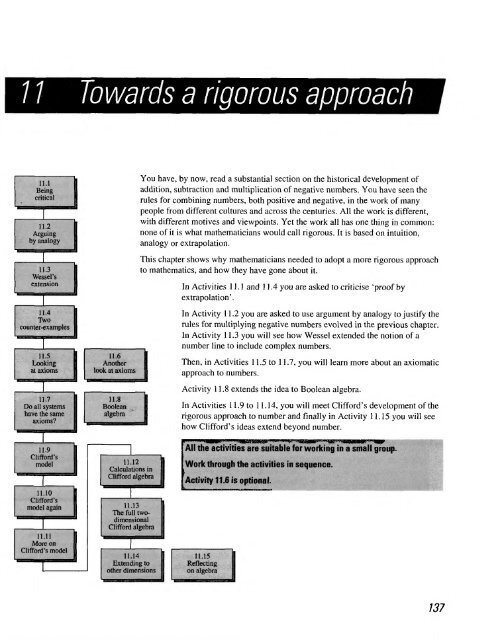history of mathematics - National STEM Centre
history of mathematics - National STEM Centre
history of mathematics - National STEM Centre
Create successful ePaper yourself
Turn your PDF publications into a flip-book with our unique Google optimized e-Paper software.
Being<br />
critical<br />
11.2<br />
Arguing<br />
by analogy<br />
11.3<br />
Wessel's<br />
extension<br />
11.4<br />
Two<br />
counter-examples<br />
11.5<br />
Looking<br />
at axioms<br />
11.7<br />
Do all systems<br />
have the same<br />
axioms?<br />
11.9<br />
Clifford's<br />
model<br />
11.10<br />
Clifford's<br />
model again<br />
11.11<br />
More on<br />
Clifford's model<br />
Towards a rigorous approach<br />
11.6<br />
Another<br />
look at axioms<br />
11.8<br />
Boolean<br />
algebra<br />
11.12<br />
Calculations in<br />
Clifford algebra<br />
11.13<br />
The full two-<br />
dimensional<br />
Clifford algebra<br />
11.14<br />
Extending to<br />
other dimensions<br />
You have, by now, read a substantial section on the historical development <strong>of</strong><br />
addition, subtraction and multiplication <strong>of</strong> negative numbers. You have seen the<br />
rules for combining numbers, both positive and negative, in the work <strong>of</strong> many<br />
people from different cultures and across the centuries. All the work is different,<br />
with different motives and viewpoints. Yet the work all has one thing in common:<br />
none <strong>of</strong> it is what mathematicians would call rigorous. It is based on intuition,<br />
analogy or extrapolation.<br />
This chapter shows why mathematicians needed to adopt a more rigorous approach<br />
to <strong>mathematics</strong>, and how they have gone about it.<br />
In Activities 11.1 and 11.4 you are asked to criticise 'pro<strong>of</strong> by<br />
extrapolation'.<br />
In Activity 11.2 you are asked to use argument by analogy to justify the<br />
rules for multiplying negative numbers evolved in the previous chapter.<br />
In Activity 11.3 you will see how Wessel extended the notion <strong>of</strong> a<br />
number line to include complex numbers.<br />
Then, in Activities 11.5 to 11.7, you will learn more about an axiomatic<br />
approach to numbers.<br />
Activity 11.8 extends the idea to Boolean algebra.<br />
In Activities 11.9 to 11.14, you will meet Clifford's development <strong>of</strong> the<br />
rigorous approach to number and finally in Activity 11.15 you will see<br />
how Clifford's ideas extend beyond number.<br />
All the activities are suitable for working in a small grouf<br />
Work through the activities in sequence.<br />
Activity 11.6 is optional.<br />
11.15<br />
Reflecting<br />
on algebra<br />
757
















